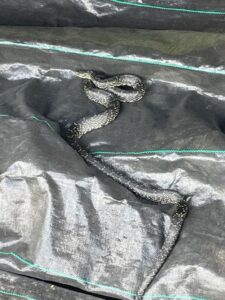Many of you have met Guin, Josephine’s mom. She’s always helpful around the farm and at the market. She’s headed back to Maine for the summer and we look forward to her return in August.
A Limited Live and Let Live Policy
We are very proud of the fact that over half of our farm property is wild space. All our farm operations, from the young apple orchard to the goat pasture, all our buildings and vegetable fields, all this sit on the 35 acres closest to the road. The back (almost) 40 is largely untouched. Plenty of space for the snakes and the birds and the salamanders and the mammals and the native ecosystem. Complete with invasive species like privet and kudzu and honeysuckle but we all have our imperfections, right?
The abundance of wild space does not exempt our work space from being home to an abundance of wildlife, too. A few weeks ago I spotted a large speckled king snake under the 50 foot box trailer where we store our shade cloths for the high tunnels. I’m always happy to see a snake. They eat mice, which awesome, because farmers and mice aren’t on the friendliest of terms. But also I just like snakes. Just the other day my mom went to get straw and found a big shed skin, so it would seem the snake is still around. Yesterday when Joseph opened the trailer that big snake fell out, practically on top of him. The yelp was heard all the way around the farm. It was Joseph who yelped, by the way, snakes aren’t big talkers.

Now as you know, king snakes are nonvenomous snakes. But our live and let live policy applies to all snakes. It’s been several years since I’ve seen a copperhead – probably because their camouflage is so on point. Cottonmouths, on the other hand, can easily be found around the pond. And sometimes in our fields. I’m ashamed to say that back in the early days of our farm we would kill a cottonmouth if we found it in the field. Now we just give them a wide berth until they move along. We once had a cottonmouth hanging out in the high tunnel for over a week preparing to shed. Once that was done the snake moved on. And did you know that nonvenomous water snakes look an awful lot like cottonmouth and also enjoy the same habitat?
There are many good reasons to leave venomous snakes alone. Firstly, most snake bites occur when someone is trying to kill or move a snake. Snakes don’t want to bite you. They don’t want anything to do with you. In addition, it doesn’t really reduce the number of snakes you have. If you have good snake habitat, which is seems we do, and plenty of snake food, which we also have, then the snakes will be there. Whether you see them or not, and whether you kill that one you just happened to see. Or not.
Where the policy ends, is in animals that eat our crops. Our apologies to Bambi, Peter Rabbit, Stuart Little, and the hispid cotton rat, which no one has chosen to immortalize as a lovable fictional character yet. These guys do not get a free pass. They can do significant damage to vegetable crops. Sometimes the solution is as simple as covering a crop with agricultural fabric to exclude rabbits, but the other rodents can be harder to control. We have found the best way to keep the deer on their designated acreage is to hunt them during deer season.
Even mowing around the field and tilling the soil is a violent disruption of nature. I am certain the death toll for toads is not zero. The farm is full of life. I suppose my point is that we are doing our best to live and let live. After all, this land belonged to the critters before it ever belonged to us.
Small Shares
- Baby Napa Cabbage
- Radishes
- Turnips
- Kohlrabi (or broccoli)
- Lettuce Mix
Full Shares
- Napa Cabbage
- Radishes
- Lacinato Kale (or broccoli)
- Head Lettuce
- Fennel
- Beets




You must be logged in to post a comment.